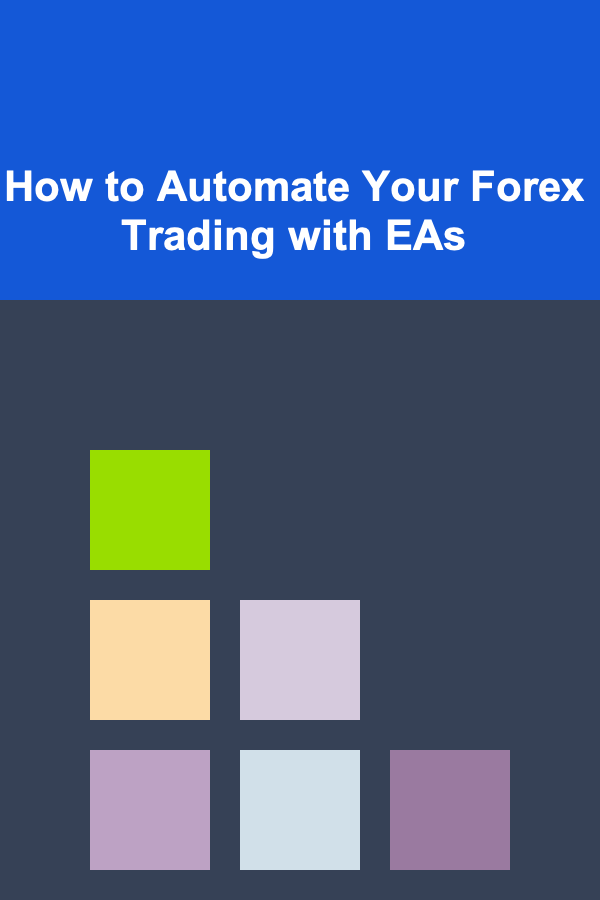
How to Automate Your Forex Trading with EAs
ebook include PDF & Audio bundle (Micro Guide)
$12.99$9.99
Limited Time Offer! Order within the next:

In the fast-paced world of Forex trading, time is of the essence, and precision is key. Many traders are looking for ways to enhance their trading strategies and make more informed decisions without spending all their time monitoring the markets. Enter Expert Advisors (EAs) -- automated trading systems that can help traders execute trades based on predefined criteria. These EAs are designed to run on trading platforms like MetaTrader 4 (MT4) and MetaTrader 5 (MT5), offering traders the ability to automate their trading strategies and free up valuable time.
Automating your Forex trading with EAs can improve efficiency, reduce emotional trading, and help you manage risks effectively. However, like any tool, the effectiveness of an EA depends on its configuration, the strategy it implements, and how well it is maintained.
In this guide, we will explore how to automate your Forex trading using Expert Advisors, including how they work, the different types of EAs, how to choose or create one, and best practices for automation in Forex trading.
What Are Expert Advisors (EAs)?
An Expert Advisor (EA) is an automated trading program designed to execute trades in the Forex market based on a set of predefined rules or algorithms. These rules can include various factors such as price, volume, time, technical indicators, and other market conditions. EAs are typically written in MQL4 or MQL5 programming languages, depending on the platform being used.
Once installed on a trading platform like MetaTrader, an EA can monitor the market, analyze data, and execute trades without the need for manual intervention. This allows traders to take advantage of market opportunities 24/7, even when they are away from the screen.
EAs offer several benefits, such as:
- Automation of Trading Strategy: Trades are executed based on a set strategy without the need for manual intervention.
- Backtesting: EAs can be tested on historical data to determine how effective a strategy might have been.
- Emotionless Trading: Automation removes emotional biases, such as fear or greed, from decision-making.
- Consistency: EAs follow a fixed set of rules, which leads to consistent execution of trading strategies.
How Do Expert Advisors Work?
The fundamental goal of an EA is to automate the process of market analysis and trade execution based on a trader's specific strategy. These are the key steps involved in how EAs work:
2.1 Market Analysis
EAs are programmed to analyze the market by using specific technical indicators or price action strategies. Common technical indicators used include:
- Moving Averages (MA)
- Relative Strength Index (RSI)
- Bollinger Bands
- Stochastic Oscillator
- MACD (Moving Average Convergence Divergence)
The EA scans real-time market data for potential trading signals based on these indicators. For example, if an EA is programmed to follow a Moving Average crossover strategy, it will look for instances when the short-term moving average crosses above or below the long-term moving average to signal a trade.
2.2 Trade Execution
Once the EA has identified a potential trading opportunity, it automatically executes a trade by opening, modifying, or closing positions. The execution is based on specific conditions programmed into the EA, such as:
- Entry Conditions: When to open a buy or sell position.
- Stop Loss: A predefined price level where the position is closed to prevent further losses.
- Take Profit: A predefined price level where the position is closed to lock in profits.
- Trailing Stop: A dynamic stop loss that moves with the price to protect profits as the market moves in favor of the trade.
2.3 Risk Management
Many EAs are designed to incorporate risk management techniques, such as position sizing, stop losses, and take profits. These features help ensure that the risk exposure on each trade is controlled and within the trader's risk tolerance.
2.4 Backtesting
Before using an EA on a live account, it is essential to test it using historical data, a process known as backtesting. Backtesting allows traders to evaluate how well the EA would have performed in the past, given certain market conditions. It provides insight into the EA's potential profitability and can help refine strategies before they are applied to live markets.
Types of Expert Advisors
There are various types of Expert Advisors, each designed to follow different trading strategies. Below are some of the most common types:
3.1 Trend Following EAs
Trend following EAs are designed to capitalize on sustained market trends. These EAs typically use technical indicators such as Moving Averages or the Average Directional Index (ADX) to determine the prevailing market trend. When a trend is identified, the EA will open positions in the direction of that trend and use stop losses and take profits to manage the trades.
3.2 Range Trading EAs
Range trading EAs focus on identifying price levels that are moving within a certain range. These EAs use support and resistance levels or oscillators like RSI and Stochastic to predict when the market is overbought or oversold. When the price reaches an extreme point, the EA opens a position anticipating the price will reverse and stay within the range.
3.3 Scalping EAs
Scalping EAs are designed for high-frequency trading, aiming to capture small price movements over short periods. These EAs typically open and close trades within minutes or even seconds, often using indicators like the MACD or the Bollinger Bands to identify small market movements.
3.4 News Trading EAs
News trading EAs are programmed to take advantage of volatile market conditions caused by major news events. These EAs analyze economic calendars and news releases to open positions based on anticipated market reactions to events such as interest rate decisions or GDP reports.
3.5 Arbitrage EAs
Arbitrage EAs are designed to exploit price discrepancies between different markets or brokers. These EAs automatically buy and sell the same asset on different platforms or exchanges when there is a significant difference in price. While arbitrage strategies can be highly profitable, they often require precise timing and access to multiple trading platforms.
How to Choose or Create an Expert Advisor
Choosing or creating the right Expert Advisor for your trading strategy can be a daunting task. Here are some steps to guide you through the process:
4.1 Assess Your Trading Goals
Before selecting or creating an EA, it's important to assess your trading goals. Are you a long-term investor, or do you prefer short-term trading? What is your risk tolerance? Answering these questions will help you decide whether a trend-following EA, range trading EA, or scalping EA is best suited to your needs.
4.2 Select a Reputable EA Provider
If you're opting to purchase or rent an EA, it's essential to select a reputable EA provider. Look for providers with proven track records and positive reviews from other traders. You can find EAs on online marketplaces like the MetaTrader Market or third-party platforms.
4.3 Understand the Strategy Behind the EA
Before using an EA, ensure that you understand the strategy it employs. Avoid blindly using an EA without understanding its logic. Many EAs come with comprehensive documentation that explains the strategy and risk management techniques used. Take the time to read this documentation and understand how the EA operates in different market conditions.
4.4 Create Your Own EA
If you're proficient in programming, you can create your own Expert Advisor using the MQL4 or MQL5 programming languages. MetaTrader provides a built-in development environment (MetaEditor) where you can write and compile custom code for EAs. Creating your own EA gives you complete control over the trading strategy, but it requires time and programming knowledge.
4.5 Test and Optimize the EA
Before using any EA on a live account, it's crucial to test it on a demo account and conduct thorough backtesting. This allows you to evaluate its performance and ensure it aligns with your expectations. You can also optimize the EA by adjusting its parameters to improve performance in different market conditions.
Best Practices for Automating Forex Trading
While automating your Forex trading with an EA can be highly beneficial, there are certain best practices you should follow to ensure long-term success:
5.1 Start with a Demo Account
Before deploying an EA on a live account, test it thoroughly on a demo account. This allows you to assess its performance without risking real money. Monitor the EA's execution closely to ensure it functions as expected.
5.2 Use Proper Risk Management
Always implement sound risk management techniques, such as setting stop-loss levels, adjusting position sizes, and diversifying your trades. Never rely solely on an EA to manage your risk.
5.3 Monitor Performance Regularly
Even though EAs automate trading, it's essential to monitor their performance regularly. Market conditions can change, and an EA that worked well in the past may not perform as effectively in different market environments.
5.4 Avoid Over-Leveraging
While EAs can automate trades, they should not be used to over-leverage your account. High leverage increases the risk of significant losses, even if the EA performs well in the short term.
5.5 Keep the Software Updated
Ensure that your EA and trading platform are kept up to date with the latest versions. Regular updates often include bug fixes, performance improvements, and enhancements that can improve your trading experience.
Conclusion
Automating Forex trading with Expert Advisors offers traders the ability to execute strategies efficiently and without emotional bias. EAs can help you trade 24/7, reduce manual effort, and take advantage of market opportunities. However, it is essential to select or create the right EA, thoroughly test it, and implement strong risk management techniques. With careful planning and execution, automated trading can be a valuable tool in your Forex trading journey.
Reading More From Our Other Websites
- [Home Maintenance 101] How to Maintain Your Home's Plumbing System for Long-Term Efficiency
- [Organization Tip 101] How to Create a Video Diary for Your Time Capsule
- [Organization Tip 101] How to Declutter Digital Files and Organize Your Computer
- [Organization Tip 101] How to Create a Decluttering Strategy for Large Workspaces
- [Organization Tip 101] How to Balance Short-Term and Long-Term Goals Effectively
- [Personal Care Tips 101] How to Revive Damaged Cuticles with Natural Oils
- [Organization Tip 101] How to Create a Mood Board for Inspiration in Your Space
- [Ziplining Tip 101] Gear Talk: Best Harnesses and Headsets for Ziplining -- An In-depth Review
- [Survival Kit 101] Top 10 Items for a Survival Kit with First Aid and Shelter
- [Home Pet Care 101] Dealing with Excessive Shedding in Pets

How to Collaborate with Schools for Educational Time Capsules
Read More
How to Tackle the Most Common Cleaning Problems in Your Home
Read More
SEO Tips for One-Page Websites: How to Rank Higher with Less Content
Read More
How to Understand Blockchain Bridges
Read More
Grasping Innovations in Allergy Treatment: A Comprehensive Guide
Read More
How to Write a Screenplay for a Low-Budget Film
Read MoreOther Products

How to Collaborate with Schools for Educational Time Capsules
Read More
How to Tackle the Most Common Cleaning Problems in Your Home
Read More
SEO Tips for One-Page Websites: How to Rank Higher with Less Content
Read More
How to Understand Blockchain Bridges
Read More
Grasping Innovations in Allergy Treatment: A Comprehensive Guide
Read More